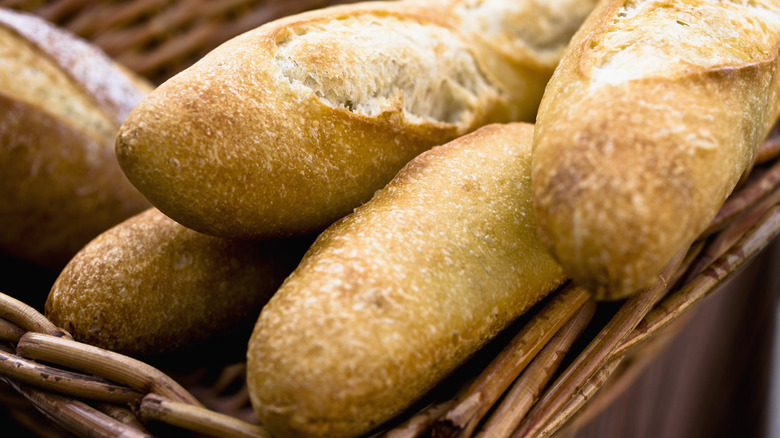How To Keep Baguettes Fresh Longer Than 2 Days
Picture it: You've just acquired a baguette from your local bakery after searching long and hard for a fresh one. You take it home and perhaps cut a couple of slices to enjoy now, but you plan on saving the rest for later. Finally, the time comes to cut a few slices off, only to discover your knife can't cut through the near rock-hard crust. Aghast, you realize your baguette has become stale after barely two days have passed. Luckily, there are ways to save your French bread without gorging yourself on an entire loaf in one sitting. These methods of preservation aren't complicated, either.
Keeping bread in an airtight environment will slow down the rate it becomes stale, so tightly encasing a baguette in aluminum foil will keep out moisture and help it last longer. It's important to make sure there aren't any holes or other ways for air to enter the protective layer. One of the best ways to ensure freshness is to completely vacuum-seal the loaf, but since not everyone owns a machine that can suck all the air out of a plastic bag, it may behoove you to squeeze all the air out of a plastic bag with a zipper instead. A word of caution, though: Storing bread in plastic will make its crust softer, but toasting a slice will help return the exterior to its crispiness.
Why does bread go stale?
The process behind how bread becomes stale is quite complex and often misunderstood. The easiest way to explain it is that bread dries out and hardens due to moisture loss. That's not a scientifically accurate way of describing the process, though. Bread actually gets stale because of the introduction of more moisture. Water helps the starch molecules inside bread form crystals that solidify its structure. In the oven, where heat is high and moisture levels are low, the starch crystals break apart, and the bread is at its softest. However, these thick molecules reform as the bread cools in a process called "starch retrogradation."
This microscopic transformation makes bread truly dry out, as water moves from the inside of the loaf to its exterior. This is why bread stales from the inside, and why the center is always the hardest while the crust can feel uncomfortably soggy. Baguettes go stale even more quickly than other bread types, because their fluffy texture comes from a lack of binding fats that trap moisture inside the crumb, like oil and butter. That means that baguettes are light and airy, but it also means there are fewer barriers preventing the moisture from leaving the bread.
What about temperature?
You may think that storing bread in the fridge may preserve its freshness, but starch crystals form at lower temperatures, making this the absolute worst place for a baguette. In fact, the optimal temperature for starch retrogradation is about 32 to 50 degrees Fahrenheit — which happens to be around the exact conditions of a refrigerator. However, low temperatures can actually stop starch retrogradation in its tracks, which means that freezing a baguette is a great way to keep it from going stale. In this case, it's helpful to freeze individual slices of the baguette and thaw them when needed. You should probably heat them up in an oven or toaster, since the baguette will go stale faster if thawed at room temperature.
If all else fails, remember that a stale baguette is never a useless baguette. If a loaf has gone stale, pouring some water on top and sticking it in the oven at around 300 degrees Fahrenheit might bring it back to life. Otherwise, you can always toast slices and turn them into croutons, or grind them up in a food processor or blender to make breadcrumbs. Alternatively, you can soften the baguette up with milk and eggs to make bread pudding or French toast. You can even use some hardened baguette pieces to thicken up a deliciously hearty soup. There's simply no use crying over stale bread.



